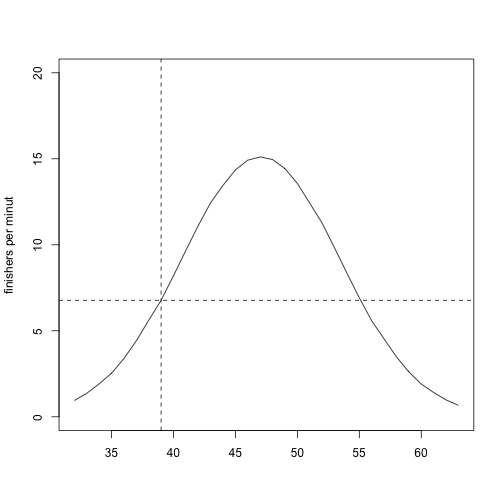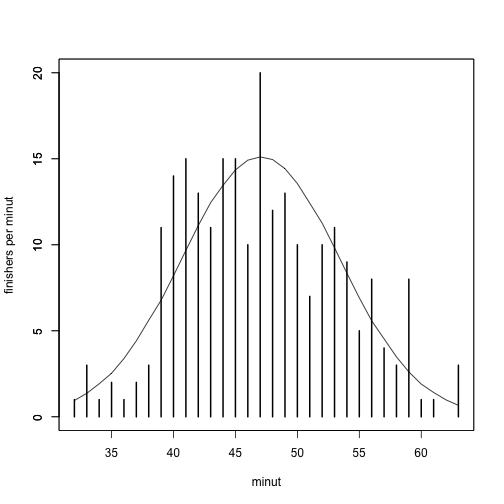Henry John-Alder told me once that in a marathon, twice as runners cross the line at 2h 59m than at 3h 00m. He pointed out that this anomaly in the distribution of finishers per minute (roughly normal shaped) is due to motivation. I believe that. I am not physically stronger than my friend Lluismo, in fact we are pretty even, but some times one of us beat the other just because he has the right motivation…
But where is the data? Can we test for that? Can we get a measure of how motivated are runners by looking at the race times distribution? The hypothesis is that runner groups that deviates from the expected finishing time distributions are more likely to contain motivated runners. It happens I did a race a couple of weeks ago, so I can fetch the results, create an expected distribution and compare that to the observed values.
I am interested in separating motivation from physical condition because is a real problem in behavioural ecology (See Sol et al. 2011). And because working with my race data is a lot of fun.
First we need to read the results from the webpage and extract a nice table:
# load url and packages url <- "http://www2.idrottonline.se/UppsalaLK/KungBjorn-loppet/KungBjorn-loppet2012/Resultat2012/" require(plyr)require(XML)require(RCurl) # get & format the datadoc <- getURL(url) doc2 <- htmlTreeParse(doc, asText = TRUE, useInternalNodes = TRUE) tables <- getNodeSet(doc2, "//table") t <- readHTMLTable(tables[[1]]) tt <- as.matrix(t) tt <- as.data.frame(tt) # Select only the 10K men class and make variable names data <- tt[c(150:391), c(2, 3, 4, 6)] colnames(data) <- c("place", "number", "name", "time") head(data)## place number name time ## 150 1 624 Hedlöf Viktor 32:52 ## 151 2 631 Vikner Joel 33:18 ## 152 3 414 Sjögren Niclas 33:47 ## 153 4 329 Swahn Fredrik 33:48 ## 154 5 278 Sjöblom Albin 34:04 ## 155 6 311 Lindgren Fredrik 35:31
Cool, we need to get the number of finishers per minute, now.
# create an 'empty' minute column
min <- c(1:length(data$time))
# if time has hour digits, transform to minutes
for (i in 1:length(data$time)) {
if (nchar(as.character(data$time[i])) > 5) {
min[i] <- as.numeric(substr(data$time[i], 3, 4)) + 60
}
}
# select just the minute value for the rest of the data
min[1:237] <- as.numeric(substr(data$time[1:237], 1, 2))
And plot the number of finishers per minute
plot(table(min), xlab = "minute", ylab = "finishers per minute", xlim = c(30,
63))
That is approximately a normal distribution! (way better than my usual ecological data). In that case, let’s create an expected perfect normal distribution with mean and sd based on this race. I will use that as the expected times in the absence of motivation. If each runner performs accordingly only to its physical conditions; given enough runners they will fall in a perfect normal distribution (that is a model assumption).
# create the density function x <- seq(32, 63, length = length(data$time)) hx <- dnorm(x, mean(min), sd(min)) # transform densities to actual number of expected finishers per minute: # create an expected (e) 'empty' vector and for each minute calculate the closest x value and its correspondence density (hx) multiplied by the number of runners. e <- c(32, 63) for (i in 1:length(c(32:63))) { e[i] <- hx[which.min(abs(x - c(32:63)[i]))] * length(data$time) } # Check the total number of runners predicted is close to the real one (242) sum(e) #close enough ## [1] 239.1plot(c(32:63), e, ylim = c(0, 20), type = "l", ylab = "finishers per minute", xlab = "") abline(v = 39, lty = 2) abline(h = 6.77, lty = 2)
So, based on the plot, I predict 6.77 runners on 39 minutes (see dashed line), and 8.20 in 40. If being below 40 minutes is a goal, we expect motivation to show up there as a deviation from the expected values… Let’s plot both things together
plot(c(32:63), e, ylim = c(0, 20), type = "l", ylab = "", xlab = "")
par(new = TRUE)
plot(table(min), xlab = "minut", ylab = "finishers per minut", ylim = c(0, 20), xaxt = "n")
Well, the observed value at 39 minutes is 11, higher than the expected 6.77, but minute 40 and 41 are also higher than expected. Maybe being around 40 is the real motivation? We can visualize the observed minus expected values as follows:
o <- as.vector(table(min))
# add a 0 on minute 61, to make vectors of same length
o[31] <- 0
o[32] <- 3
# calculate difference
diff <- o - e
plot(c(32:63), diff, xlab = "minutes", ylab = "difference")
abline(h = 0, lty = 2)
Not a super clear pattern. But positive values for the first half of the finishers indicates motivation, however, take into account that positive values on the second part imply demotivation. Let’s do the sums:
sum(diff[1:16]) #1st half part## [1] 10.75sum(diff[17:32]) #second half## [1] -7.892
The distribution is skewed to observe faster times than expected. I interpret this as an indication that most people was in fact motivated (half first part of the finishers deviations >> second half). We could have asked the people, but if you work with animals, they don’t communicate as clear (and humans can lie!). So, Is this approach useful? Maybe if instead of 242 runners and 10 k I use the NY marathon data, it will give us a clearer pattern? We will never know because is time to go back to work.





“You wanted to know how I beat you (Vicent to his genetically modified brother after he won him in a swimming race). That’s how I did it, Anton. I never saved anything for the swim back.”
That’s the best comment I could get (and you knew it)!
Thanks : )
I have to admit it, I haven’t read the whole post but one question comes to me since I’ve started reading. Do those runners get a best result because of theirs motivations or are they more motivated since they get a better result?
¿Which came first, the chicken or the egg?
Sources of motivation are probably infinite. Having good results can also motivate you for the next race. Your girlfriend cheering too…
Pingback: Runner stats | ecoblender
More discussion here: http://www.ecoblender.org/?p=196
And a conceptual framework for clarification here: https://img.skitch.com/20121007-g36c8b3kmmmmn3hiaqgbmam7gf.jpg